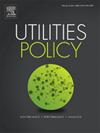Empowering Saudi Arabia's sustainable energy future: A LEAP-Based approach for balancing energy supply and demand
IF 4.4
3区 经济学
Q3 ENERGY & FUELS
引用次数: 0
Abstract
Electricity demand in Saudi Arabia is experiencing a volatile upward trend, driven by fluctuations in population and GDP. With non-Saudis making up 40 % of the population, shifts in government policies have directly impacted these numbers, stalling potential growth. Using the Long-range Energy Alternative Planning System (LEAP), four future energy supply and demand scenarios are explored: (1) Low Growth (LG), (2) Medium Growth (MG), (3) High Growth (HG), and (4) High Growth with Demand Management and Energy Efficiency (HGDE). By 2035, demand could soar from 328.6 TWh in the LG scenario to 518 TWh in the HG scenario. Emissions in the LG scenario are projected at 62.1 MMtCO2E, increasing to 103.8 MMtCO2E in the HG scenario. The implementation of Vision (2030) targets is crucial to supporting this growth.
赋予沙特阿拉伯可持续能源的未来权力:基于跨越式发展的能源供需平衡方法
在人口和国内生产总值波动的推动下,沙特阿拉伯的电力需求正在经历一个不稳定的上升趋势。由于非沙特人占人口的40%,政府政策的变化直接影响了这些数字,阻碍了潜在的增长。利用长期能源替代规划系统(LEAP),探讨了四种未来能源供需情景:(1)低增长(LG),(2)中等增长(MG),(3)高增长(HG)和(4)高增长与需求管理和能源效率(HGDE)。到2035年,需求将从LG情景中的328.6太瓦时飙升至HG情景中的518太瓦时。LG情景下的排放量预计为6210万吨二氧化碳当量,HG情景下的排放量将增加到1.038亿吨二氧化碳当量。落实《愿景(2030)》目标对于支持这一增长至关重要。
本文章由计算机程序翻译,如有差异,请以英文原文为准。
求助全文
约1分钟内获得全文
求助全文
来源期刊

Utilities Policy
ENERGY & FUELS-ENVIRONMENTAL SCIENCES
CiteScore
6.80
自引率
10.00%
发文量
94
审稿时长
66 days
期刊介绍:
Utilities Policy is deliberately international, interdisciplinary, and intersectoral. Articles address utility trends and issues in both developed and developing economies. Authors and reviewers come from various disciplines, including economics, political science, sociology, law, finance, accounting, management, and engineering. Areas of focus include the utility and network industries providing essential electricity, natural gas, water and wastewater, solid waste, communications, broadband, postal, and public transportation services.
Utilities Policy invites submissions that apply various quantitative and qualitative methods. Contributions are welcome from both established and emerging scholars as well as accomplished practitioners. Interdisciplinary, comparative, and applied works are encouraged. Submissions to the journal should have a clear focus on governance, performance, and/or analysis of public utilities with an aim toward informing the policymaking process and providing recommendations as appropriate. Relevant topics and issues include but are not limited to industry structures and ownership, market design and dynamics, economic development, resource planning, system modeling, accounting and finance, infrastructure investment, supply and demand efficiency, strategic management and productivity, network operations and integration, supply chains, adaptation and flexibility, service-quality standards, benchmarking and metrics, benefit-cost analysis, behavior and incentives, pricing and demand response, economic and environmental regulation, regulatory performance and impact, restructuring and deregulation, and policy institutions.
 求助内容:
求助内容: 应助结果提醒方式:
应助结果提醒方式:


